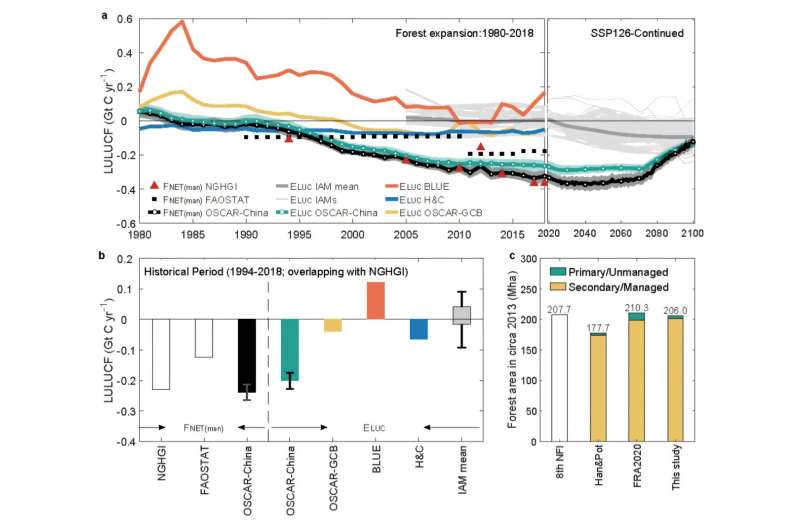
December 27, 2024 by Peking University
Collected at: https://phys.org/news/2024-12-boost-china-carbon-sequestration-potential.html
A team of researchers led by Professor Piao Shilong at the Institute of Carbon Neutrality of Peking University (PKU) has made significant advances in understanding how China’s land-use changes—such as forest planting—can contribute to the country’s efforts to reduce carbon emissions.
Their study, published in Nature Communications, offers fresh insights into China’s carbon removal capacity through land-use, land-use change, and forestry (LULUCF), a key strategy for achieving carbon neutrality by 2060.
As part of its commitment under the Paris Agreement, China has pledged to become carbon neutral by 2060, meaning it will need to balance the amount of carbon dioxide it emits with the amount it can remove from the atmosphere. One important way to achieve this balance is through land-based solutions, particularly forestation, which helps capture and store carbon.
However, there has been uncertainty about how much carbon China’s forests can actually sequester due to varying estimates and models. This new research helps clarify the role of land-use changes in China’s carbon budget and provides more accurate projections for future carbon removal.
Key findings
- China’s forests are a vital carbon sink: The study confirms that China’s ongoing forestation efforts—planting trees and restoring forests—have turned the country’s land-use changes into a significant carbon sink, meaning more carbon is absorbed by the land than is emitted. From 1994 to 2018, China’s forests absorbed a substantial amount of carbon, aligning with the country’s national greenhouse gas inventories.
- The role of forestation in carbon neutrality: If China continues its afforestation efforts at the current rate, its forests could offset a significant portion of emissions that are difficult to reduce through other sectors, such as energy and industry. In fact, continued forestation could help China meet about one-third of the emissions that remain hard to abate by 2060.
- Limits to carbon capture over time: However, the study also emphasizes that the carbon sequestration potential from forestation has its limits. As available land for new forests becomes scarce, the rate of carbon removal will slow. The study predicts that after the mid-century, the capacity of forests to capture carbon will begin to decline as land-use opportunities diminish.
- Long-term strategies are crucial: The research highlights the need for sustained forestation efforts beyond 2035, when China’s current forestation targets are expected to be met. This continued expansion is crucial for maximizing the carbon removal potential of the LULUCF sector and ensuring that China stays on track for carbon neutrality.

This study offers more precise estimates of China’s carbon removal from land-use changes by using an improved modeling approach. The researchers used a version of the OSCAR model specifically tailored for China (OSCAR-China) to better reflect the country’s land-use changes. This new model integrates both direct and indirect effects of land-use changes, offering a clearer picture of how much carbon China’s forests are actually capturing.
The findings provide valuable insights for policymakers as they look to enhance China’s carbon sequestration strategies. While forestation is an important tool for reducing emissions, the study also stresses that China cannot rely solely on land-use changes to meet its carbon neutrality goal. Ongoing efforts across all sectors, including energy and industry, will be necessary to reduce emissions on a larger scale.
Furthermore, the research underlines the importance of improving carbon accounting methods to ensure that land-based carbon sequestration is accurately measured.
The paper, titled “Future Land Carbon Removals in China Consistent with National Inventory,” was co-authored by He Yue, Assistant Researcher at Peking University, and Professors Piao Shilong and Thomas Gasser from IIASA.
More information: Yue He et al, Future land carbon removals in China consistent with national inventory, Nature Communications (2024). DOI: 10.1038/s41467-024-54846-2
Journal information: Nature Communications

Leave a Reply